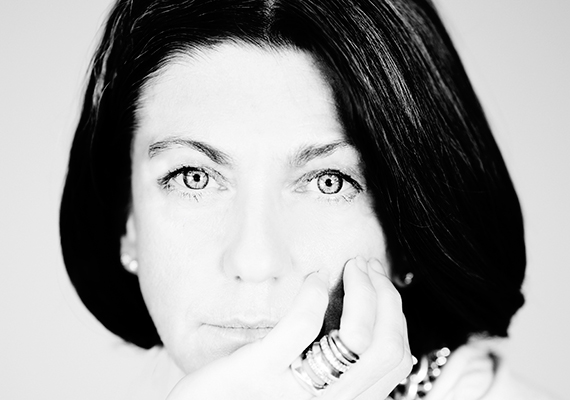In the world of architecture and design, few women run global businesses. Nicoletta Canesi manages one from her home base in Miami.
A graphic and interior designer by training, Canesi keeps a steady hand on the Lissoni Associati group that now employs about 100 people on three continents. She and her better-known partner Piero Lissoni founded the group in Italy in 1986 and now have offices for their varied firms in Milan, New York, Miami and Tokyo. He’s typically out front with creative concepts that often feature clean lines; she’s more often behind-the-scenes, busy with negotiating, organizing teams and overseeing projects – including some she’s designed herself.
Lissoni Associati has designed consumer products, hotels, residences and other projects in Holland, Israel, China, Argentina and beyond, often working with the same clients for decades. Canesi spearheaded the group’s recent U.S. expansion. In Miami, her team is working on two luxury condo projects that both debuted last week as part of Art Basel/Miami Art week.
Canesi, 58, spoke with The Real Deal about her Miami projects, designing for sunny South Florida, working in the meeting-heavy U.S. market and being a woman in a male-dominated industry.
The interview has been edited for clarity and brevity.
Q: Tell us about your main projects in the Miami area.
A. One is the Ritz-Carlton Residences, Miami Beach, which used to be the Miami Heart Center. We couldn’t tear the hospital down, because otherwise, it would be impossible to build such a large structure there. So, we did a surgical demolition to bring light to the areas inside and created 111 apartments. The biggest challenge was that the hospital was made from six different buildings built at different times starting the 1940s.
We did the re-design of the façade for the main building, interior design for the common areas and pool terrace, and architecture for the villas. There will be 15 villas, some on the canal and some behind. They’re two-stories, and we cut out some areas inside to create terraces, add light and gain privacy between them.
We also have Oceana Bal Harbour, which is 240 apartments. We did interior design for all common areas, bathrooms and kitchens in the apartments, and selected the materials for clients to choose for flooring in their apartments.
Q. How does designing for Miami differ?
A. What we took as inspiration was the light. Miami has a special, strong light and feeling of the outside. At the Ritz-Carlton, the building has huge terraces, some that seem the same size as the apartment. I imagine people on some terraces having a coffee looking at the sunrise and others enjoying drinks at sunset.
We also pay a lot of attention to height, because honestly, many apartments in Miami have low ceilings. In Europe, we’re used to 12-foot ceilings. So, where we can, at least in common areas, we like to give people here a sense of space. High ceilings make you relaxed, happy and bring in more light.
Q. What about materials for Miami? Some designers like white on white.
A. At Ritz-Carlton, the building and screens are white, but inside, we wanted a warm feeling. In the main common areas, the floors are a grayish marble and walls off-white stucco. Some accent furniture is dark wood, and we have Chinese chairs, low African tables, modern vases, a collection of African masks on a wall…, so it’s kind of eclectic, very refined and kind of timeless.
Q. How did you start in Miami, and how does it compare with other sites?
A. I came kind of by chance. We got a project in the Turks & Caicos Islands that was supposed to be a Mandarin Oriental hotel. And we had a project in Miami on Watson Island called Island Gardens, with a hotel and residences; it now has a deck overlooking a marina.
Here in the United States, you have such a different way of working. You have so many meetings. Our projects in Shanghai, in Tokyo, in the Emirates where we are building a resort-town, we manage everything from Italy and go there once a month, maybe.
But here, you have meetings every week, or a lot of times, more than one meeting. And if we have not one but two or more projects, you can’t fly back every week. So, that’s why we started an office in Miami. We also have an office in New York, and I usually spend two or three days a week there — when I’m not in our projects in Cancun or Buenos Aires. I have very good assistants, but I’ve realized that when I don’t show up for more than one meeting here, some clients here get nervous. They want you to be there, talking with them.
Q. What’s it like being a woman running a global company in the male-dominated field of architecture and design?
A. There are more and more successful women in the profession. And yes, a lot of times I go to a meeting, and I’m the only woman. But I don’t feel uncomfortable.
My partner is a man with a very strong character; he’s demanding. I’ve learned working with Piero first, and then, working on my first big project by myself in Turkey how to talk with men on the job. It’s usually better not to say a straightforward “No.” You have to say, “Yes, but maybe if we do this…” and get them on your side. It’s a process.
I think women are more open to doing this than men are. It comes more naturally. In Latin, they say, “The drop makes a hole in the stone.” I’m kind of like that. When people don’t like what I say, I don’t persist in the moment. But maybe the next day, you find a way to bring it again. There’s a way to make your decision become theirs.
